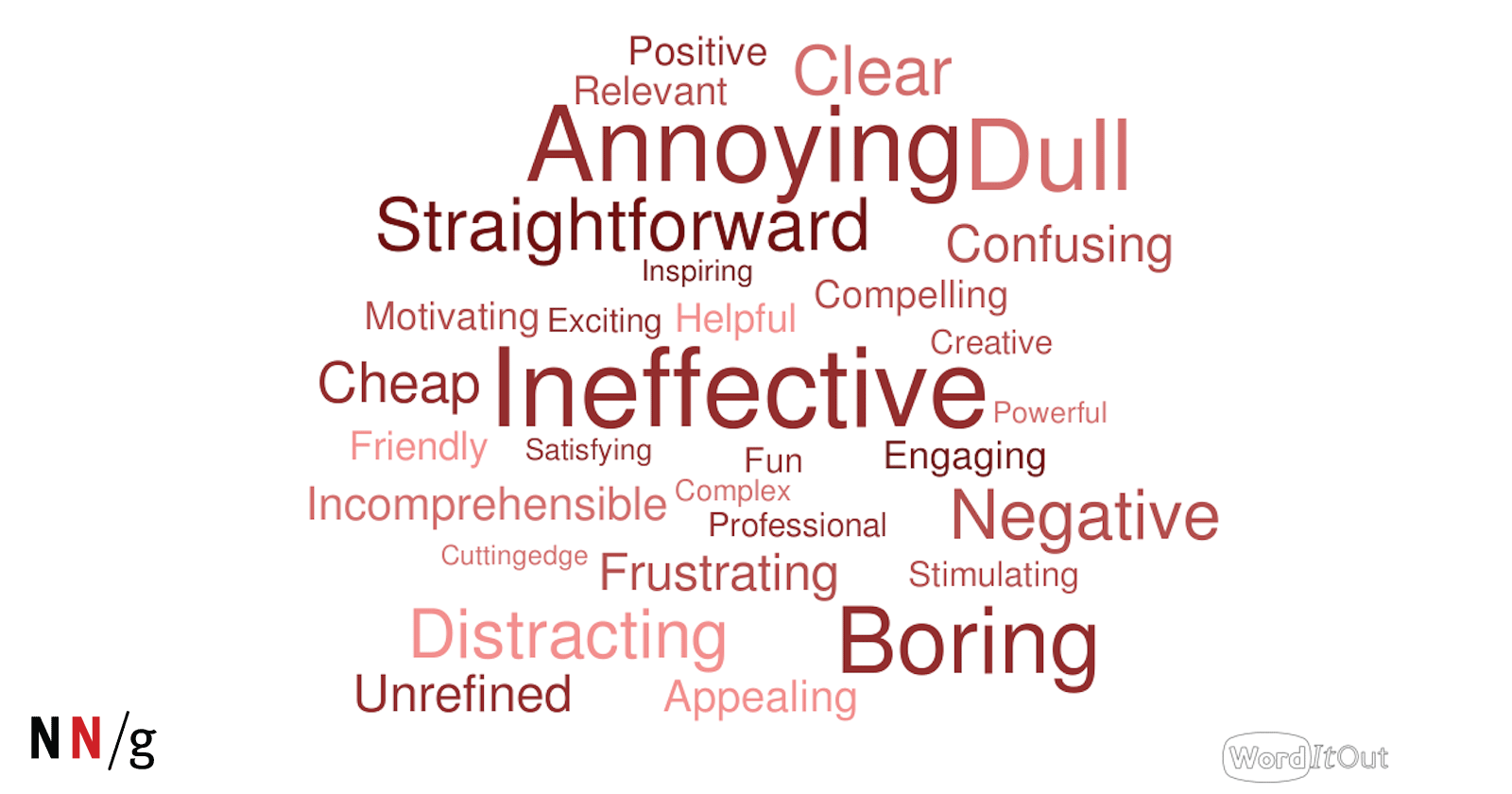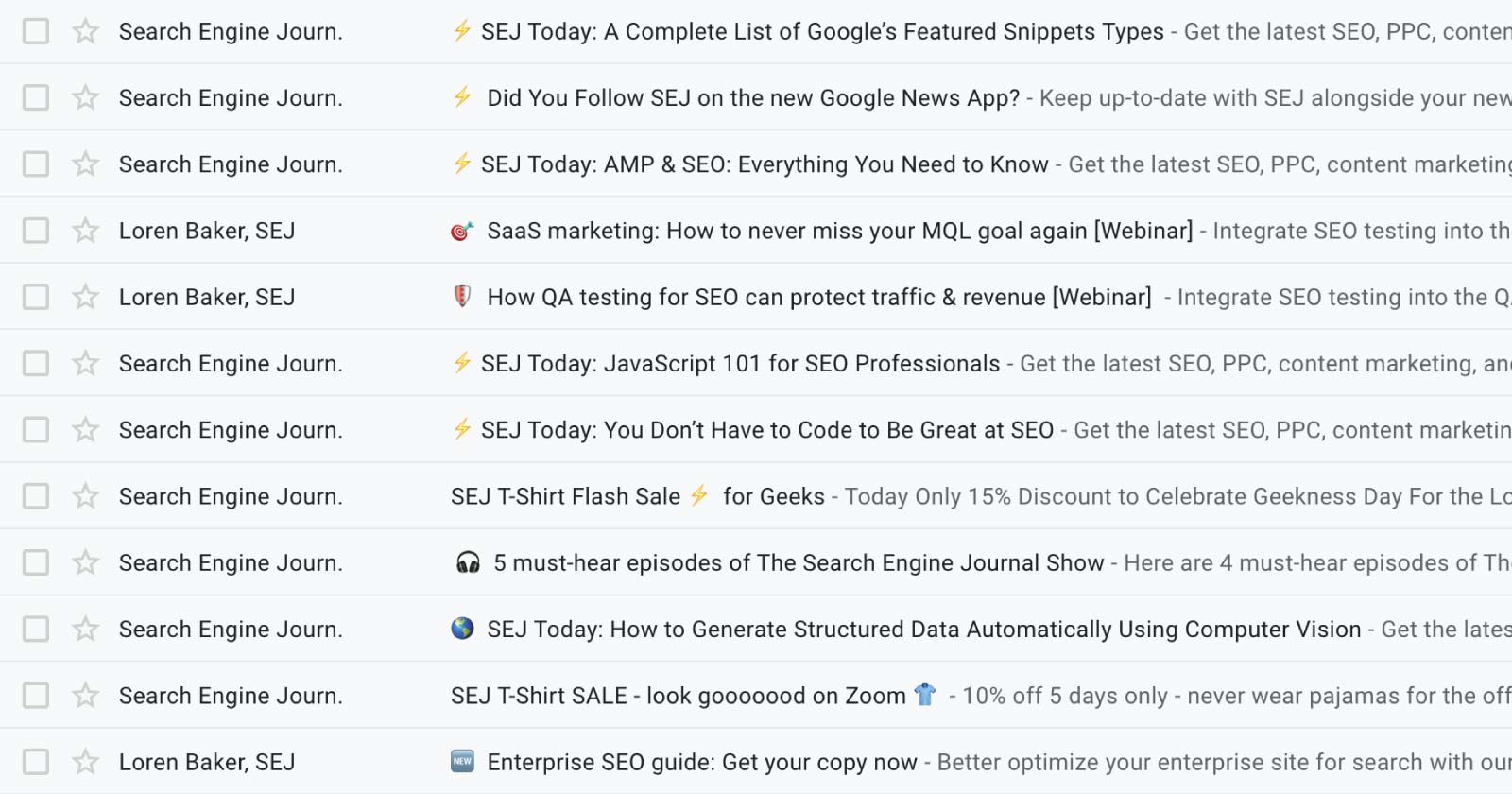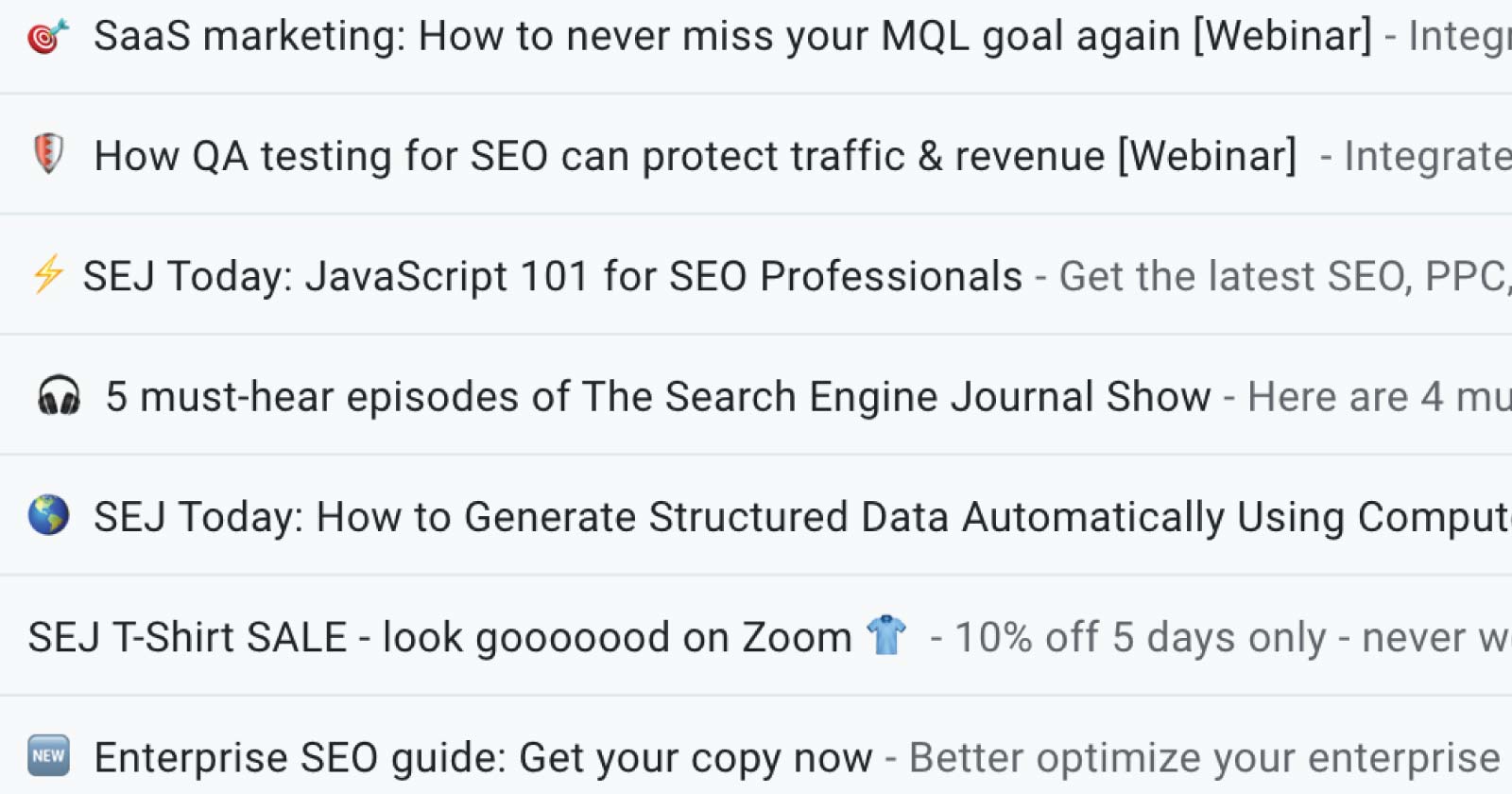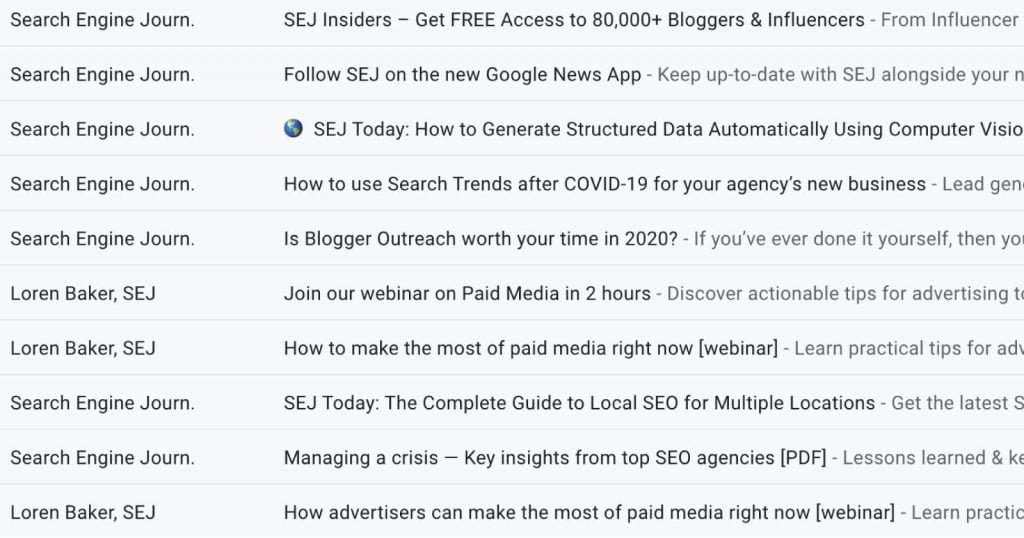Are you a big fan of using emojis in your email subject lines?
You might want to think again.
Why?
I just tested 3.9 million emails and found two surprising things…
😮
I’ve long suspected that emojis might not be sending the best brand message when used in email.
And then, an article dropped into my feed that showed evidence that emojis can cause negative sentiment. I was all over it!
As I’m managing the email communications here at Search Engine Journal, I have the perfect opportunity to run my own testing with a generous sample size of 110,000 subscribers.
And, we love testing stuff here.
So, over two months in June and July, I ran a variety of email tests with emojis in subject lines.
I wanted to see if I could discern any audience behavior surrounding their response to the emoji.
The sharp-eyed among you will notice that over the last few months there has been a variety of emojis appearing on email subject lines in the SEJ Today newsletter. This is why.
Advertisement
Continue Reading Below
The main question I wanted to answer was:
Can emojis in subject lines affect open rates?
Short answer: not necessarily.
Long answer: the results shown were not so clearly defined but with two surprising results.
The Subject Line Is the Most Important Part of the Email, Not an Afterthought
Email marketing is firstly all about the open rate and secondly, click-through rate.
The subject line bears the weight of this.
It has to get attention immediately and stimulate the reader to act – all before the email can even begin to get the message across.
For this reason, subject lines are the most vital part of the email just like an ad headline.
But I’m probably telling you anything you don’t already know.
An Emoji Stands Out, So It Must Get Attention, Right? 😀😊😐😕😟😡
If you imagine your inbox as a list of statements all fighting for your attention and shouting out “pick me”, “pick me” – any edge that helps focus your eye is going to win, wouldn’t you think?
Advertisement
Continue Reading Below
There’s a preconception that emojis grab attention by catching the eye and drawing the reader to the subject line.
Therefore, that increases the open rate – because once someone sees the subject line, they click.
Right?
Well, actually, there’s little evidence to support the claim that emojis increase open rate.
Just because an emoji stands out and catches your eye, doesn’t mean that the user will click.
And, it might be getting attention for the wrong reason.
Just Because You Get Attention, It Doesn’t Mean Your Reader Likes It
If you inserted a shock word, like “f*ck”, into a subject line, your eye is quickly going to see that and all your focus goes to that word.
But just because your attention goes to that word doesn’t mean you open it.
You can also be highly offended by it.
Even if the reader does open the email, it doesn’t mean they want to connect with the email.
Your reader might just be looking for the unsubscribe button.
And this is where sentiment comes into play.
 The word cloud pictured represents the word used by participants to describe emails with emojis in the subject line.
The word cloud pictured represents the word used by participants to describe emails with emojis in the subject line.Research experts Nielsen tested a variety of emails and asked their participants to select from a list of reaction words that best described the email.
Ironically, the words “boring” and “dull” were selected far more to describe the emails that included an emoji in the subject line.
Advertisement
Continue Reading Below
That appears to go against what you would expect.
More importantly, emails without emojis were considered to have more value.
So, it’s not just about getting attention that counts.
Aside from sentiment, the perception of your authority can also be of great importance (especially in brand communications).
Research in 2017 showed that in a work context, the use of emojis decreased perception of competence, which undermines information sharing.
How would you react to an email about a legal or financial report if it liberally used emojis 👏 and 👏 hand 👏 claps 👏. Hmmmm 😱.
This is why you should never make assumptions or blindly follow what another company/person/neighbor is doing, without a level of understanding what is working for your reader.
For example, testing in 2017 from Return Path showed positive engagement for emojis over a variety of seasonal occasions.
But, all of these emails were informal seasonal events and one-off emails across different email lists.
Novelty can quickly wear thin.
Taking into consideration what Nielsen found, I wanted to look at the Search Engine Journal audience and see how they respond to emojis.

Emoji Testing Methodology
Over a two-month period from June to July 2020, I tested email subject lines across:
Advertisement
Continue Reading Below
- Our daily newsletter.
- Monthly newsletter.
- Merchandise and other announcements.
- Webinar emails.
- Sponsored emails.
In total, 3,893,391 emails were measured from 17 email campaigns.
Every email was A/B tested, most (but not all) with three variations:
- ⚡ Emoji at the front of the subject line
- Emoji at the end of the subject line ⚡
- No Emoji in the subject line
A variety of emoji designs were tested, but the same emoji was always used in each email for click consistency.
The emojis I used across the different emails were:
🌎 ⚡ 📰 👕 🎓 🔥 🚀 🎯 🔗 ⏲️ 📈 🛡️
I always used an emoji relevant to the subject (as much as possible).
The exception was for SEJ Today. Due to limitations in how we send the email, we couldn’t directly A/B test for every individual email sent.
Advertisement
Continue Reading Below
In this case, I measured emails from June against July, for 20 days in each month.
I also used just one variation of emoji at the front of the subject line or no emoji.
Open Rate
The overriding metric I wanted to qualify was open rate and if more people open emoji-based emails.
Firstly, I counted the number of campaigns (17) and then added a column for emoji or non-emoji.
Each row (for a campaign) scored a ‘1’ in the relevant column if the campaign open rate was higher for emoji or non-emoji.
The sum of campaign wins was totaled for each side and divided by the number of campaigns to find the percentage.
The comparison of wins for emoji versus non-emoji returned the answer that subject lines without an emoji had the higher open rate at 52.94% to 47.06%.
That said, what constitutes a win for each campaign was often marginal.
For example, 11.24% compared to 11.26% – I saw this across the board.
The one area where we had the most difference was for SEJ Today.
Advertisement
Continue Reading Below
The one weakness in this data is that we didn’t do a direct A/B but had to test month-on-month.
Not ideal, but it was still a win.
| Subject line | Emoji open rate | No emoji open rate |
| 🌎 SEJ Today: Daily title came here for 10 days | 20.34% | 23.07% |
| ⚡ SEJ Today: Daily title came here for 10 days | 19.72% | 20.85% |
Click-Through Rate (CTR)
Based on the results for open rate, CTR testing was the first of two surprising results which appeared totally out of line with the rest of the testing results.
And not what I expected at all.
Click-through results showed that when users did open the emails, there was a higher click-through rate for the emails that had an emoji in the subject line.
The campaigns that had a higher CTR was 64.71%.
11 out of 15 campaigns had a higher click-through rate (two were negated because they had equal CTRs).
This could be an indication that in our niche, more users are adept and familiar with using emojis.
Advertisement
Continue Reading Below
For some email marketers, a higher click rate would balance in favor against a reduced open rate, so it could be worth the trade-off.
Unsubscribes
Next, I wanted to test the Nielsen theory of negative sentiment and looked at two metrics; the first was unsubscribes.
The number of people who unsubscribe from the list upon receiving the email being a reasonable indication of sentiment.
I found the CTR surprising – this result was the strongest out of all the testing.
It showed 70.59% compared to 29.41% in favor of the non-emoji emails. The second surprise result.
This indicated that emails with emojis in the headline had a higher unsubscribe rate.
Does this clearly show a negative sentiment?
It’s difficult to qualify that when the amount of unsubscribes falls into such a small volume of around 2%.
But, this was the one result that showed such a strong bias.
This neatly leads on to possibly one of the most important reflections of sentiment – the abuse report.
Advertisement
Continue Reading Below
Abuse Complaints
Being reported for email abuse is the dread of every email marketer because this can have a direct impact on your inbox placement rate.
This spells the difference between your email landing into the spam folder or into the inbox where you want to be.
Too many complaints and your account can be suspended by your email client.
Every email marketer can get abuse complaints.
One complaint is quite usual on most of the emails we send out, although most of ours will have none.
Considering we send to a list of over 100, ooo, this is pretty insignificant and should not be a worry.
The best email in the world will get at least one complaint.
The number of abuse complaints for an email campaign is a strong indication of the relevancy of the email content to your audience and should be something you watch closely.
In our direct comparison of emoji versus non-emoji campaigns, there was a strong winner.
Advertisement
Continue Reading Below
Emails with emojis in the subject line showed more abuse complaints with 7 out of 10 campaigns having more abuse reports than non-emojis.
Only 3 of the non-emoji campaigns had more abuse complaints. The other 7 campaigns had an equal number and were not counted.
When we look at the uplift of abuse complaints and the unsubscribe rate, this does underline the Nielsen findings of negative sentiment towards emoji.
The most significant number of complaints in one single email was for SEJ Monthly which featured a newspaper emoji in the subject line. This had 3 complaints.
We rarely see 3 complaints in a campaign, so this did stand out.
| Subject line | Emoji abuse report | No emoji abuse report |
| SEJ Monthly: Best Stories from May 2020 | – | 1 |
| 📰 SEJ Monthly: Best Stories from June 2020 | 3 | 0 |
| SEJ Monthly: Unmissable Reads from July | – | 0 |
Where Should You Place the Emoji in the Subject Line?
Regardless of the open rate result, another question I wanted to try and answer was if the placement of the emoji in the subject line made a difference.
Advertisement
Continue Reading Below
Should the emoji be placed at the front or at the end of the email?
Out of the data I had, I focused on the comparison between the emoji subject lines only and measured if the front or the end of the subject line had the higher open rate.
This was regardless of if the email had a higher open rate for emoji versus non-emoji.
I also discounted SEJ Today and Monthly as they were only sent out with the emoji at the front of the subtitle.
7 out of 12 campaigns showed a bias towards a better open rate with the emoji being placed at the end of the subject line.

Conclusion
The results of the testing were close.
Advertisement
Continue Reading Below
There was only a minimal percentage difference for open rates in individual campaigns.
So, this doesn’t give me the definitive answer with inconclusive results I hoped to find.
However, when looking at the results of the campaigns in comparison to each other, we do see some indication of the following:
- Emojis in subject lines show a slightly lesser open rate and non-emoji subject lines are preferable.
- Regardless of open rate, emails with emojis have a higher click-through rate.
- Users unsubscribe more for emails that have emojis in the subject line…
- …and users make abuse reports more for emails with an emoji in the subject line.
- If you do want to use emojis, placing at the end of the subject line is the favorable position.
The conclusion I draw after this experiment is this:
Emojis could create negative sentiment for a brand.
But, I reserve my opinion because I didn’t test widely across a variety of niches.
Always Be Testing (Your Subject Lines)
My preference is for a clean subject line and consider the use of strong messaging and keywords the most effective way to get attention.
Classic rules of psychology and persuasion will always be my preference.
However, that’s not to say that in certain niches there isn’t a place for emojis.
Advertisement
Continue Reading Below
For any brand that is considering using them in their email campaigns, I would suggest conducting your own basic testing.
Something you should be doing on a regular basis anyway.
My recommendation would always remain to be audience focused and consider this above all else.
If my client were the Financial Times, I would be very hesitant to test emojis in subject lines.
If I was working for Walmart, then I would.
And, if you do use them, don’t forget to test the position – at the front and the end 👋.
More Resources:
Image Credits
Word Cloud Image: Nielsen
All screenshots taken by author, September 2020
